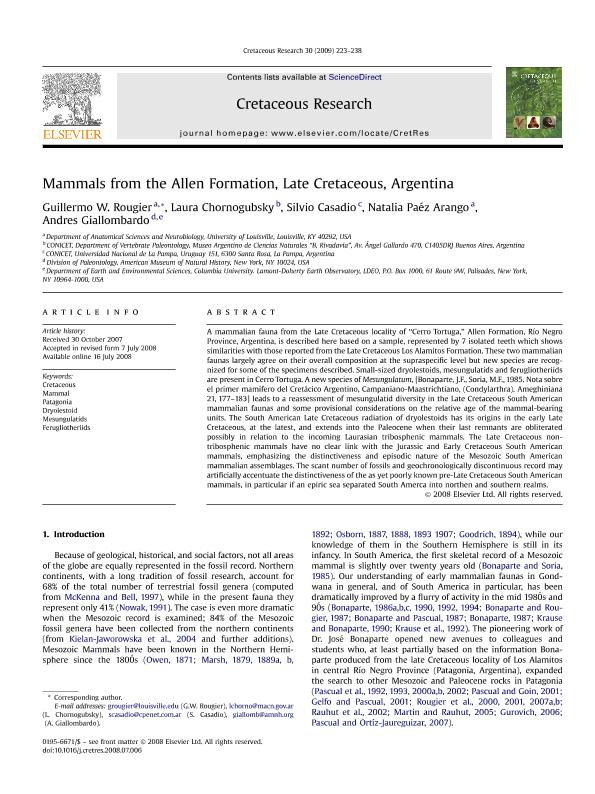Mostrar el registro sencillo del ítem
dc.contributor.author
Rougier, Guillermo Walter

dc.contributor.author
Chornogubsky Clerici, Laura

dc.contributor.author
Casadio, Silvio Alberto

dc.contributor.author
Arango, Natalia Paéz
dc.contributor.author
Giallombardo, Andres
dc.date.available
2020-04-23T13:53:59Z
dc.date.issued
2009-02
dc.identifier.citation
Rougier, Guillermo Walter; Chornogubsky Clerici, Laura; Casadio, Silvio Alberto; Arango, Natalia Paéz; Giallombardo, Andres; Mammals from the Allen Formation, Late Cretaceous, Argentina; Academic Press Ltd - Elsevier Science Ltd; Cretaceous Research; 30; 1; 2-2009; 223-238
dc.identifier.issn
0195-6671
dc.identifier.uri
http://hdl.handle.net/11336/103413
dc.description.abstract
A mammalian fauna from the Late Cretaceous locality of “Cerro Tortuga,” Allen Formation, Río Negro Province, Argentina, is described here based on a sample, represented by 7 isolated teeth which shows similarities with those reported from the Late Cretaceous Los Alamitos Formation. These two mammalian faunas largely agree on their overall composition at the supraspecific level but new species are recognized for some of the specimens described. Small-sized dryolestoids, mesungulatids and ferugliotheriids are present in Cerro Tortuga. A new species of Mesungulatum, [Bonaparte, J.F., Soria, M.F., 1985. Nota sobre el primer mamífero del Cretácico Argentino, Campaniano-Maastrichtiano, (Condylarthra). Ameghiniana 21, 177–183] leads to a reassessment of mesungulatid diversity in the Late Cretaceous South American mammalian faunas and some provisional considerations on the relative age of the mammal-bearing units. The South American Late Cretaceous radiation of dryolestoids has its origins in the early Late Cretaceous, at the latest, and extends into the Paleocene when their last remnants are obliterated possibly in relation to the incoming Laurasian tribosphenic mammals. The Late Cretaceous non-tribosphenic mammals have no clear link with the Jurassic and Early Cretaceous South American mammals, emphasizing the distinctiveness and episodic nature of the Mesozoic South American mammalian assemblages. The scant number of fossils and geochronologically discontinuous record may artificially accentuate the distinctiveness of the as yet poorly known pre-Late Cretaceous South American mammals, in particular if an epiric sea separated South Amerca into northen and southern realms.
dc.format
application/pdf
dc.language.iso
eng
dc.publisher
Academic Press Ltd - Elsevier Science Ltd

dc.rights
info:eu-repo/semantics/openAccess
dc.rights.uri
https://creativecommons.org/licenses/by-nc-sa/2.5/ar/
dc.subject
CRETACEOUS
dc.subject
MAMMAL
dc.subject
PATAGONIA
dc.subject
DRYOLESTOID
dc.subject.classification
Paleontología

dc.subject.classification
Ciencias de la Tierra y relacionadas con el Medio Ambiente

dc.subject.classification
CIENCIAS NATURALES Y EXACTAS

dc.title
Mammals from the Allen Formation, Late Cretaceous, Argentina
dc.type
info:eu-repo/semantics/article
dc.type
info:ar-repo/semantics/artículo
dc.type
info:eu-repo/semantics/publishedVersion
dc.date.updated
2020-04-22T14:42:47Z
dc.journal.volume
30
dc.journal.number
1
dc.journal.pagination
223-238
dc.journal.pais
Estados Unidos

dc.description.fil
Fil: Rougier, Guillermo Walter. University of Louisville; Estados Unidos
dc.description.fil
Fil: Chornogubsky Clerici, Laura. Consejo Nacional de Investigaciones Científicas y Técnicas. Oficina de Coordinación Administrativa Parque Centenario. Museo Argentino de Ciencias Naturales "Bernardino Rivadavia"; Argentina
dc.description.fil
Fil: Casadio, Silvio Alberto. Consejo Nacional de Investigaciones Científicas y Técnicas; Argentina. Universidad Nacional de La Pampa; Argentina
dc.description.fil
Fil: Arango, Natalia Paéz. University of Louisville; Estados Unidos
dc.description.fil
Fil: Giallombardo, Andres. Columbia University; Estados Unidos. American Museum of Natural History; Estados Unidos
dc.journal.title
Cretaceous Research

dc.relation.alternativeid
info:eu-repo/semantics/altIdentifier/doi/https://doi.org/10.1016/j.cretres.2008.07.006
dc.relation.alternativeid
info:eu-repo/semantics/altIdentifier/url/https://www.sciencedirect.com/science/article/pii/S019566710800092X
Archivos asociados
